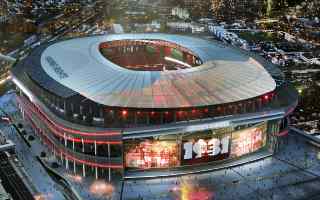Estádio do Flamengo
| Capacity | 78 000 |
|---|---|
| Country | Brazil |
| City | Rio de Janeiro |
| Clubs | Flamengo |
| Category | Design awaiting implementation |
| Cost | R$1.93 B ($331.6 M) |
| Construction | 2026–2029 |
| Design | Arena Events+Venues |
Advertisement
Estádio do Flamengo – design description
How did plans to build a new stadium for Flamengo come about?
Flamengo, Brazil's most popular football club, was founded in 1895 as a rowing club, and its football section has been active since 1911. The team has (intermittently) played at the famous Maracanã since it opened in 1950. Over the years, Flamengo has shared it with other Rio de Janeiro teams.
For some time Flamengo had been considering moving out of the Maracanã. As early as the turn of the 20th century, plans were made to expand the club's former facility, Estádio da Gávea, but these were not realized. Later ideas included building a new stadium on Avenida Brasil or at the Olympic Park in Barra da Tijuca, or moving out to any of the city's existing stadiums.
Why does Flamengo want to move out of the Maracanã?
The Maracanã is one of the most famous stadiums in the world and playing there certainly adds prestige. However, Flamengo does not own the stadium outright and must share it with other users. When it was managed by the private company Odebrecht, there were quite a few disagreements over the lease, although this problem disappeared after the local government terminated its contract with the company in 2019.
Maracanã, moreover, does not offer the same commercial opportunities as an own modern facility. Although the stadium underwent a major upgrade before the 2014 World Cup, it still has a somewhat archaic, oval-shaped layout of the stands.
Recently, the club has begun to enjoy other spectacular successes, such as victories in the Copa Libertadores in 2019 and 2022, and there has been an increase in attendance, which has not been without influence on the decisions made regarding the stadium.
Where will the new stadium for Flamengo be built?
In July 2022, Flamengo targeted an area known as Gasômetro de São Cristóvão. This was a plot of land left over from a former gas tank that operated at the site for nearly a century. The gasometer was decommissioned in 2005, and as of 2009 the state-owned financial institution Caixa Econômica Federal owned the site.
The site was in an area that was attractive for investment, close to the city center and Guanabara Bay, and relatively close to the Maracanã. The club's negotiations with Caixa were difficult, and after two years of fruitless efforts, Rio de Janeiro's mayor, Eduardo Paes, decided to intervene, leading to the expropriation of the land in June 2024.
In July 2024, the city held an auction to purchase the plot, with Flamengo making the only bid, at just under R$138.2 million. After negotiations with Caixa, which dropped further claims after the club paid an additional R$7.8 million, Flamengo finally took over the Gasômetro site on October 3, 2024.
When was the plan to build a new stadium for Flamengo presented?
Following the acquisition of the land for the stadium, the club began work on the project. A feasibility study was commissioned to Arena Events+Venues. Preliminary renderings and information about the future stadium appeared in the media as early as June 2024.
On November 22, 2024, at Flamengo's headquarters, the study prepared by Arena Events+Venues was presented at a meeting with club members. Information from the study was also made public and reported in the media.
Arena Events+Venues has prepared quite detailed plans for the new stadium, along with attractive renderings. However, the club noted that this is only a preliminary concept, and the final vision will be determined through an architectural competition.
What does the preliminary plan for a new stadium for Flamengo entail?
According to Arena Events+Venues' vision, the new facility is expected to receive a capacity of about 78,000 spectators (similar to the Maracanã), becoming one of the largest stadiums in Latin America. The facility will be equipped with the latest technology and commercial features that will allow it to operate 365 days a year.
Among other things, the stadium will feature a club store and museum, bars and restaurants, and attractions such as Latin America's first circular video screen, which will be suspended under the roof, as well as an observation deck and a special rooftop pathway from which visitors will be able to look down on the field and the stands... along with the club's mascot, the condor, whose sculpture will stand at the edge of the canopy.
The facility will have a number of premium options, including hospitality areas, boxes and skyboxes. Much of the audience, however, will be offered at affordable prices. Seating for the most ardent fans is to be the stand behind the north goal, which will be divided into only two levels to facilitate match choreography.
The stadium will be a football-specific one, with its design inspired by the local culture and passion of Flamengo fans. The stadium will be dominated by the club's colors, red and black. A large multimedia screen will be built on the façade of the north stand, and there will be a square in front of it where fans will gather.
There will be 1,600 parking spaces within the facility. In addition, the venue is to stand right next to the new transportation hub (Terminal Intermodal Gentileza).
What role will the new Flamengo stadium play?
The investment will provide Flamengo with a state-of-the-art facility that meets modern standards, which should significantly increase revenues and help strengthen the club's position. The new stadium is also expected to make the area more attractive and support the local economy.
In addition to Flamengo matches, the facility will be suitable for hosting many other high-level sporting and cultural events, such as NFL games and concerts by music stars.
An interesting aspect is that Flamengo's move to its own stadium will leave only Fluminense at the Maracanã, and each of Rio de Janeiro's four big clubs (in addition to those mentioned, also Botafogo and Vasco da Gama) will henceforth play in a separate stadium.
When will the new stadium for Flamengo be built?
Site surveys, project preparation and bureaucratic procedures, including obtaining the necessary permits, are expected to take about two years, after which construction can begin. The club is targeting the opening of the new stadium on November 15, 2029, in time to celebrate Flamengo's 134th anniversary.
How much will the new Flamengo stadium cost?
The investment is expected to cost R$1.93 billion. The club assumes that it will be able to finance the construction from new sources of revenue, including largely through the sale of the stadium's naming rights, which have been evaluated at R$1.5 billion for a 20-year period. In addition, construction is expected to be aided by funds raised from the pre-sale of seats (including skyboxes) at the stadium and the sale of so-called “potencial construtivo”.
Advertisement
Renderings
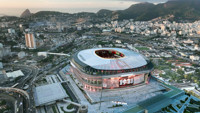
2024 © ARENA Events+Venues / Clube de Regatas do Flamengo 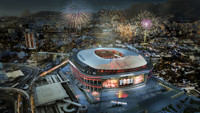
2024 © ARENA Events+Venues / Clube de Regatas do Flamengo 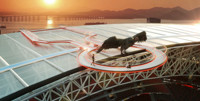
2024 © ARENA Events+Venues / Clube de Regatas do Flamengo 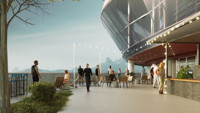
2024 © ARENA Events+Venues / Clube de Regatas do Flamengo 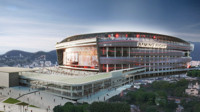
2024 © ARENA Events+Venues / Clube de Regatas do Flamengo 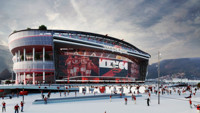
2024 © ARENA Events+Venues / Clube de Regatas do Flamengo 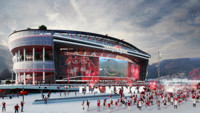
2024 © ARENA Events+Venues / Clube de Regatas do Flamengo 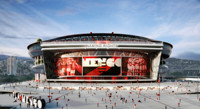
2024 © ARENA Events+Venues / Clube de Regatas do Flamengo 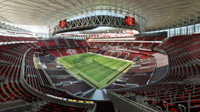
2024 © ARENA Events+Venues / Clube de Regatas do Flamengo 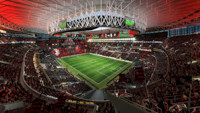
2024 © ARENA Events+Venues / Clube de Regatas do Flamengo 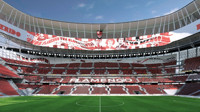
2024 © ARENA Events+Venues / Clube de Regatas do Flamengo 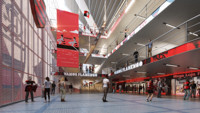
2024 © ARENA Events+Venues / Clube de Regatas do Flamengo 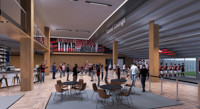
2024 © ARENA Events+Venues / Clube de Regatas do Flamengo 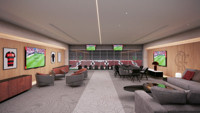
2024 © ARENA Events+Venues / Clube de Regatas do Flamengo 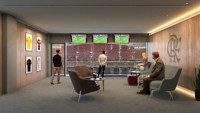
2024 © ARENA Events+Venues / Clube de Regatas do Flamengo 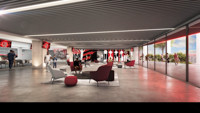
2024 © ARENA Events+Venues / Clube de Regatas do Flamengo
Related news
2025
-
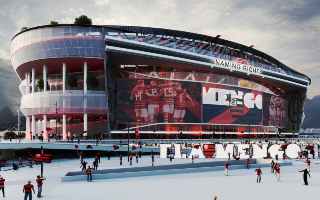
Brazil: Contaminated soil halts Flamengo's dreams. Stadium construction delayed?
Flamengo's plans to build a modern stadium in the heart of Rio de Janeiro have encountered a serious obstacle. The need to decontaminate the site of the former Gasômetro industrial plant has forced a delay in the timeline by at least two years.
-
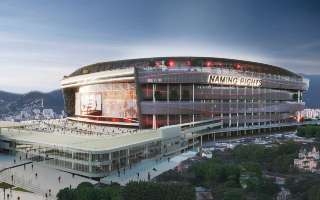
Brazil: Flamengo's new board approaches stadium construction with caution
In his first month as president of Flamengo, Luiz Eduardo Baptista began restructuring the club according to his plans. However, away from the spotlight, he also tackled a topic that had been somewhat forgotten since the club's elections.

 StadiumDB
StadiumDB